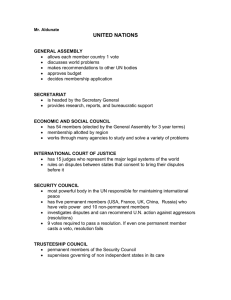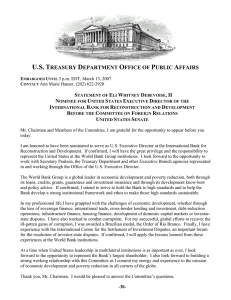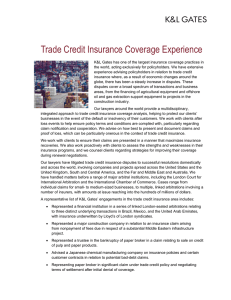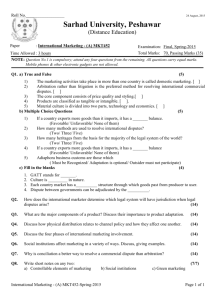1 Malaysia has set its vision to be a fully developed... industry has set it own vision to be ‘among the...
advertisement
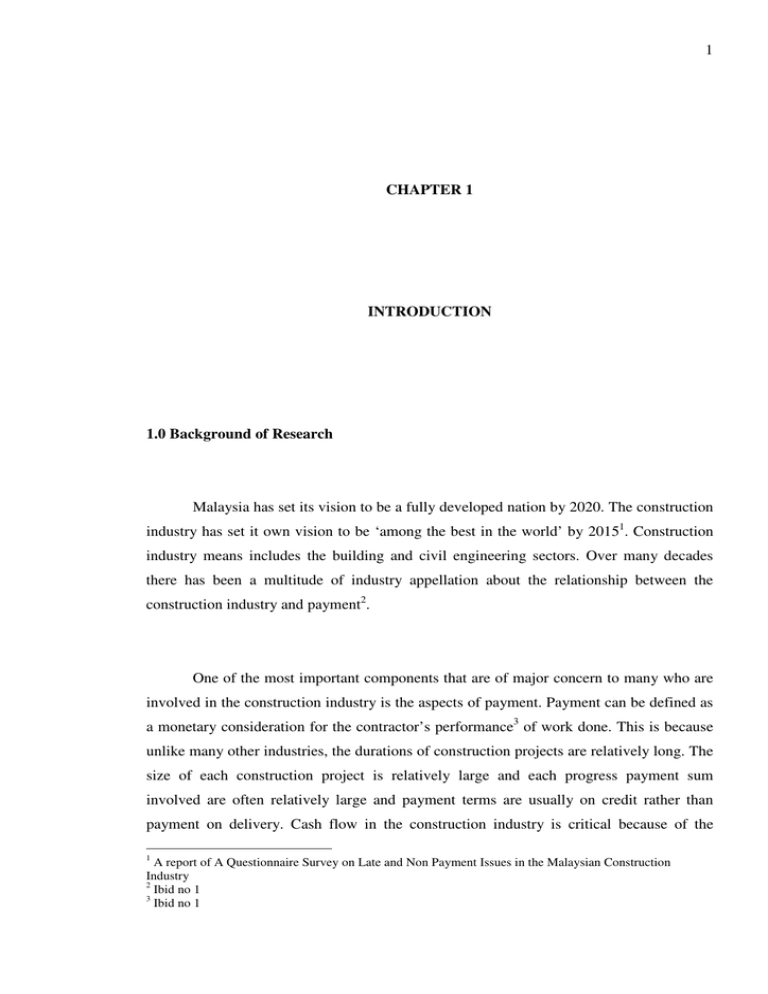
1 CHAPTER 1 INTRODUCTION 1.0 Background of Research Malaysia has set its vision to be a fully developed nation by 2020. The construction industry has set it own vision to be ‘among the best in the world’ by 20151. Construction industry means includes the building and civil engineering sectors. Over many decades there has been a multitude of industry appellation about the relationship between the construction industry and payment2. One of the most important components that are of major concern to many who are involved in the construction industry is the aspects of payment. Payment can be defined as a monetary consideration for the contractor’s performance3 of work done. This is because unlike many other industries, the durations of construction projects are relatively long. The size of each construction project is relatively large and each progress payment sum involved are often relatively large and payment terms are usually on credit rather than payment on delivery. Cash flow in the construction industry is critical because of the 1 A report of A Questionnaire Survey on Late and Non Payment Issues in the Malaysian Construction Industry 2 Ibid no 1 3 Ibid no 1 2 relatively long duration of projects. A planned expected revenue flow is usually represented by an S curve. Any deviation due to either project delays or cash flow delays can have a major impact on the projects. Therefore, payment has been referred as the lifeblood of the construction industry because construction projects involve large capital and take a long time to complete4. Nowadays, construction payment disputes in construction industry always occur and can be attested by many court cases reported in court proceedings, various law journals and law reports. Construction issues and disputes grow from variety of causes as reported in the cases. There are major issue on payment default which is non-payment; late payment, under payment and others related issues in the construction industry. Beside that, everyone in the construction industry pays all appropriate amounts due in a timely manner. Everyone means everyone involved in the delivery chain of construction projects. They include client (both public and private sectors), construction consultants involved in construction projects such as architects, engineers and quantity surveyors, main contractors, sub-contractors, sub-sub-contractors and suppliers. A payment dispute has also been associated with the types of form used such as PAM 98, PWTC, CIDB, JKR 203 and etc. Construction Industry Development Board (CIDB) Malaysia is collaboration with the construction industry has moved forward for the enactment of Construction Industry Payment and Adjudication Act to improve cash flow problem in the Malaysian construction industry. 4 Ameer Ali (2005) A “Construction Industry Payment and Adjudication Act” – Reducing Payment – Default and Increasing Dispute Resolution Efficiency 3 1.1 Problem Statement Payment remains a chronic problem in the Malaysian construction industry affecting the entire delivery chain5. In addition of that, the quantum of payment for works and services rendered in the construction industry are often huge in the millions of Ringgit. The industry works only continue to work provided that those works and services are properly paid. A study of the construction payment disputes causes has been carried out such as non payment for certified sums, late payment, under payment, and the consumer and the people involved. But these are the general findings and some other elements have to be determined. This is because construction is a complex process involving many activities, myriads of individual, different company or firms, different size, part of country with different skills and capabilities and always subject to changing environment. Construction payment disputes can have serious implication in construction projects. The project may suffer cost and time overrun, the owner may suffer significant loss and profit and worst still the project may be abandoned or failed. As a client in any construction project, they are also trying to avoid any disputes during the construction and they do not want any lengthy litigation process in resolving disputes. Over the years, many payment disputes have been referred to arbitration or line end up in court. They are either brought up by the employer, contractors, sub-contractors, suppliers and or consultants. The process of settlement of payment through arbitration or litigation is costly and lengthy which may at the end create an adversarial at morpheme among the parties. As we have all know everyone is not been to go through the tedious and lengthy process of arbitration or litigation. Therefore, it is essential that disputes of any limed should be avoided. This can be done by anticipating the disputes before they occur. It is important to understand the elements of the many disputes that have been reported by developing a profile of each case and identify the general pattern of the disputes such as 5 Noushad Ali Naseem. (2005). Construction Industry Payment and Adjudication Act. International Forum Construction Industry Payment Act and Adjudication. Kuala Lumpur : CIDB and ISM. 4 the size, location, complexity, type of projects, the nature of the claims, the plaintiff and etc. The issues are which elements is actually the common subject matter of the payment disputes? What is the nature of the payment disputes? Who are the parties involved? How long the time of disputes occurred? And what kind of standard form involved? 1.2 Objective The objectives of this research are: (a) To develop the profiles of payment disputes cases brought to Malaysian court and to identify the general pattern or attributes of payment disputes. 1.3 Scope of Research The primary data of this research is based on court cases relating to payment disputes in construction industry. The relevant court cases are limited to those reported in Malaysia Law Journal (MLJ) and available in the database of Lexis Nexis6 website through its own search engine from the year of 1995 – 2009. Through the electronic database, there 6 http:/www.lexisnexis.com 5 were Thirty (30) court cases identified from the past nineteen (19) years in Malaysia Law Journal (MLJ) which is in relation with payment dispute in construction industry. 1.4 Significant of Study The drive to maximise positive cash flow will continue to lead to disputes about payment. The disputes predominantly about payment issues are becoming larger and more complex. There are various avenues that are available to improve the payment problem in the construction industry and some of these options have been incorporated in the construction contract or statutes in the other developed countries. Few choose and adopt the best solutions which best suits and serve the Malaysian construction industry. The payment predicament of the construction industry cannot be singly explained. All parties including the owners, consultants, contractor’s subcontractors, suppliers and even public sector employers have an important role and must act in concert to take ownership of the problems and challenges. To this end, the industry as a whole must collaborate and focus on their synergies to eliminate as much as possible poor, inefficient and outdated payment practices and smoothen cash flow supplies down the payment supply chain. The multitudes of difficulties associated with payment are generally faced by all participants in construction industry: main contractor, sub-contractor and professionals. Therefore, this also increases the awareness of both contractors and employers in relation to the payment issues. It will also provide the contractors with a better understanding of their rights to payment and their legal position if payment is in default. The research is also expected to grab the attention of the employers in making their payments promptly and timeliness. This will lead to improved working relationship between the contractors and employers. 6 This study addresses the current problems in relation to payment issues encountered by contractors in the local construction industry. Findings of this study may assist the relevant parties in addressing problems associated to payment in an effective and timely manner to create a win-win situation for all parties in the Malaysian construction industry. 1.5 Research Methodology Careful thought and planning in the preparation of the research methods, data collection techniques and measurements is very important for conducting research. Generally, this research process consisted of five stages, which involved identifying the research issue, literature review, data collection, data analysis, and conclusion. Initially, a literature review was undertaken to study and understand the problems of payment in construction industry and review the contractual provisions in relation to payment in building contract. It was carried out using published journals, textbooks and PAM 1998 Form of Building Contract. This was extended further using the research and information papers from the Construction Industry Development Board (CIDB). In order to meet the goals and objectives, the primary data collection was based on the Malaysia Law Journal (MLJ) court cases. It was carried out using the university’s library online e-database via the Lexis-Nexis7 website. Difficulties were experienced in collecting and identifying the sample court cases from the online e-database due to the large number of irrelevant court cases and lack of time. The selection of sample court cases involved a depth study rather than a random sample. 7 http:/www.lexisnexis.com. 7 To achieve the research objectives, a systematic research process had been drawn up and adhered to. The research process consists of four major stages, namely, identifying the research issue, data collection, data analysis and writing. Each stage is depicted in detail below. Research Issue *Payment disputes *Profile of payment disputes Research Objective *Develop profile of payment disputes cases brought to court Literature Review * Payment * Disputes Analysis *Analysis court cases Conclusion *Conclusion 1.5.1 Research Issue Identifying the research issue is the initial stage of the whole research. To identify the issue, firstly, it involves discussion with lecturer and reading on variety sources of 8 published materials, such as journals, articles, seminar papers, and previous research papers or other related research papers and electronic resources as well through the World Wide Web and online e-databases from University of Technology Malaysia, UTM library’s website. 1.5.2 Research Objective The objective of this research is to develop the profiles of payment disputes cases brought to Malaysian court and to identify the general pattern or attributes of payment disputes. 1.5.3 Literature Review Literature review is the third stage of the research. Literature review will be involved the collection of documents which from secondary data for the research, such as books, journals, newspapers. Indeed, published resources like books, journals, varies standard form of contract, and related statutory are the most helpful in this literature review stage. Besides this, reported court cases from different sources like Malaysian Law Journal and Building Law Reports will be referred. 9 1.5.4 Analysis In this stage, it is able to determine whether the stated objectives have been achieved or vice versa. Different types of analysis will be carried out according to the requirements of the objectives. 1.5.5 Conclusion Conclusion and recommendations is the final stage of the research. In this stage the findings will be able to show the result of the research. A conclusion needs to be drawn inline with the objectives of the research. At the same time, some appropriate recommendations related to the problems may be made for a better solution in relation to the said problem. 1.6 Organization of the Thesis Briefly, this research is related to the present problems of payment and associated legal issues in the Malaysian construction industry. The outline for this research includes: 10 1.6.1 Chapter 1 – Introduction This chapter contains an issue which is perspective of the issue related to paymentdefault in construction industry. It develops the problem statement and outline of objective, scope and methodology of this research. 1.6.2 Chapter 2 – Payment Disputes Issue in Construction Industry This chapter studies and examines the present dilemmas in relation to payment default in the Malaysian construction industry. Its problems and effects to the construction industry are discussed. 1.6.3 Chapter 3 – Construction Law and Standard Form of Contract in Malaysia This chapter considers the contractor’s right to payment and remedies under common law. Related contractual provisions in standard forms of building contract are also highlighted. 11 1.6.4 Chapter 4 – Profiling This chapter studies the concept or theoretically of profiling such as the meaning, and the importance to construction. This chapter will further discuss the elements of profiling such as nature of payment dispute, parties involved such as the employer, architect, quantity surveyor, engineering, etc, type of the project like building construction, engineering construction or residential construction. 1.6.5 Chapter 5 – Profiles Of Court Cases In Relation To Payment Disputes in Construction Industry This chapter provides the primary data information. The analysis and findings based on the court cases are discussed and illustrated. 1.6.6 Chapter 6 – Recommendations and Conclusion This is conclusion of the research. It provides summary of the major findings, recommendations for the payment issues, the conclusion of the study and the recommendations for further construction works as a references.
